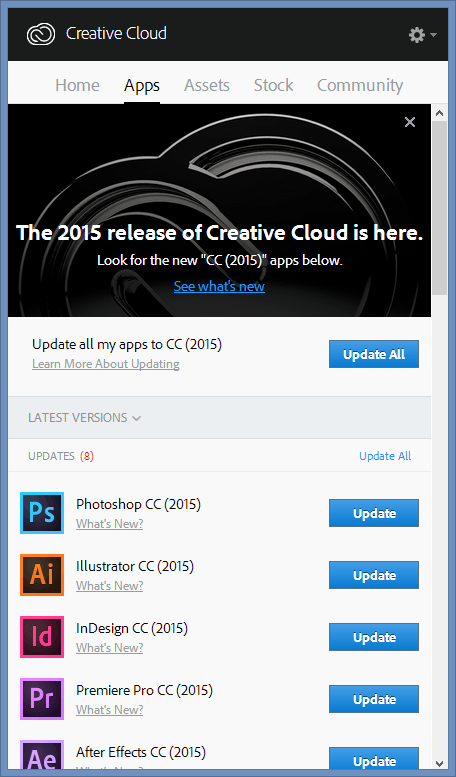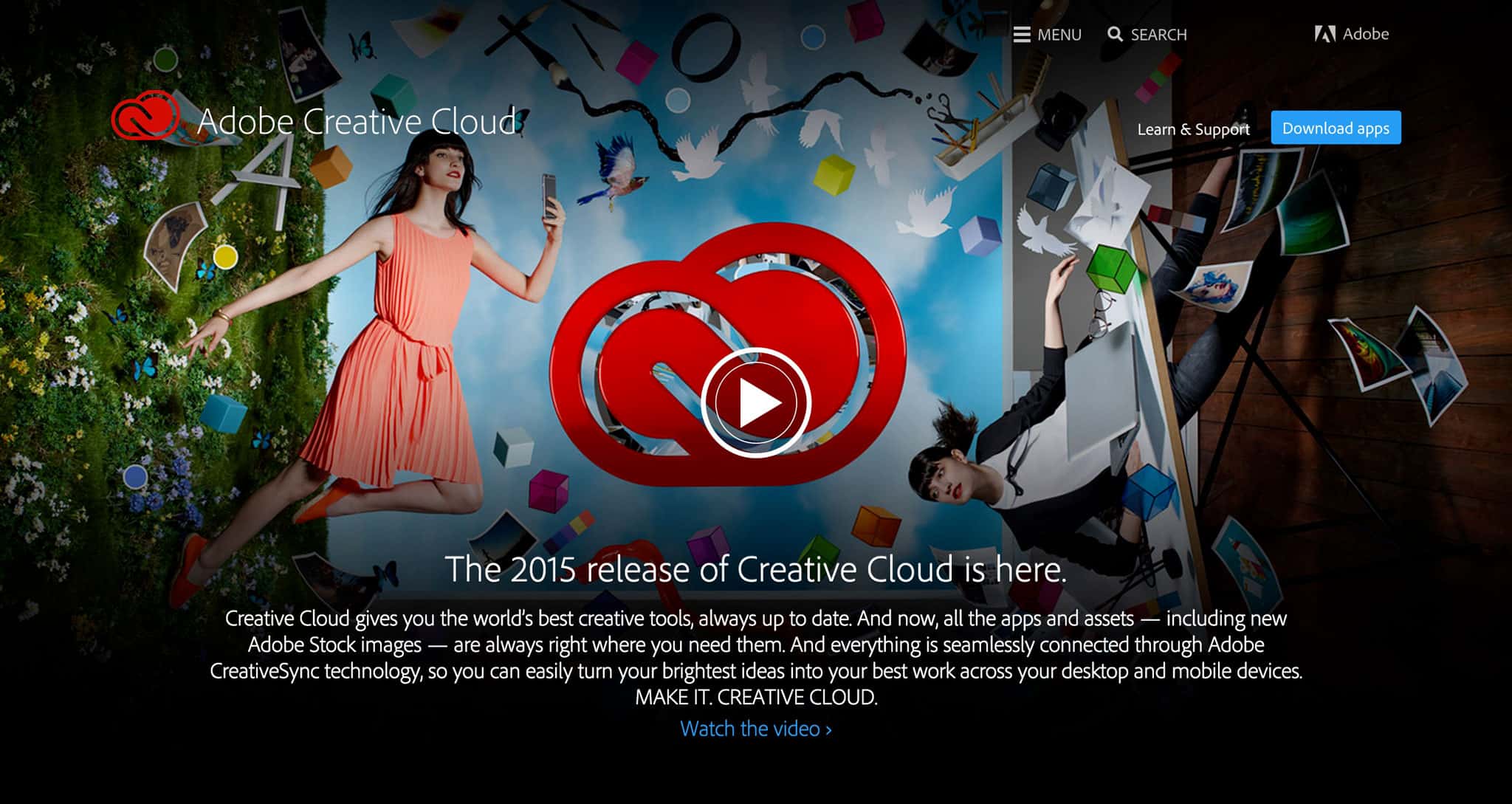Adobe has announced and released its annual update to its Creative Cloud suite of tools. There is definitely something in it for everyone, as the suite now includes around two dozen applications across several platforms — 15 on the desktop and at least 8 on mobile — and encompasses just about every media. Here we’ll focus on some of the highlights, and then give you a rundown of the other enhancements.
Incremental improvements in Photoshop
Second to Lightroom (we wrote about its 2015 version when it launched earlier this year) the application of most interest to our readers is Photoshop. Adobe has provided a nice grab bag of features and performance improvements in the 2015 version, although nothing earthshaking. If you are a Creative Cloud paid subscriber, of course you get them all for free. If you aren’t already, then it is unlikely any are large enough to convince you to suddenly sign up.
Strictly speaking, Adobe CC 2015 Master Collection is not a package issued by Adobe itself, but rather a collection made by enthusiast users. It combines all Creative Cloud 2015 components with integrated updates as well as several tools from the CS6 version. The collection has a single installer, which gives the user an opportunity to sel. Adobe has released the all new Creative Cloud 2015 Updates! But what's in it for photographers? Well we'll have a look in this video. First off, you need to. The 2015 release of Creative Cloud delivers on that vision of a creative platform that lets you work seamlessly across desktop and mobile devices—with deep integration between our mobile apps and our desktop apps, a connected assets-based workflow, a vibrant and growing marketplace, and community features built right in.
For starters, there is a new Dehaze tool, which helps bring out contrast in low-contrast scenes. It is similar in functionality to the ClearView tool in DxO’s Optics Pro. Adobe didn’t have pre-release code we could test with our own images, but based on the sample images shown here, it does a great job on cutting through fog, haze, or other atmospheric effects that lower contrast. We’ll be putting it through its paces now that the application is available, and paying special attention to whether it avoids nasty artifacts when used on images with varying amounts of haze and texture.
Adobe Dehaze sample before and after images show how it can greatly reduce the effect of fog
A more subtle enhancement in Photoshop 2015 is the ability to add noise to Blur Gallery effects, in order to create more natural looking results. Also, recognizing the growing importance of creating assets for mobile devices and multiple targets, Photoshop has added a Device Preview capability, as well as support for multiple art boards in a single file. Performance improvements in Photoshop 2015 include speedups of 120x for the Healing Brush and Patch tool (over the CS6 version). Android users get some love as well, with formerly-iOS-only Photoshop companion apps Color CC, Shape CC, Brush CC, and Photoshop Mix all being made available this month.

CreativeSync: Design once, use everywhere
Adobe has been working really hard to make it easy for its users to move from device to device. The latest iteration of this is CreativeSync, that allows you to synchronize any of your files and assets across devices. It is paired with an integration of Creative Cloud Libraries into Adobe’s major design applications, so that you can make use of your brushes and other assets easily from any of your Creative Suite programs. Adobe has extended this capability to its new Adobe Hue application (previewed at NAB as “Project Candy”) that allows videographers to capture images of uniquely lit scenes and create “Looks” out of them, for use in their video projects.
DIY Character animations

One of the coolest new features of CC 2015 is the Character Animator. It is an extension to After Effects that allows you to quickly record animations of 2D characters (Puppets), including facial expressions, lip movements, and other actions. It uses your webcam to track your head movement and facial expressions, and map them onto the puppet. Similarly, your microphone is used to move the puppets mouth as if it was speaking or singing the same words. For other actions, mouse-enabled control points are provided.
The result is a simple and fun way to create fairly reasonable cartoon animations involving one or more characters. After following a quick Getting Started tutorial, I was able to successfully animate the included puppets by changing my facial expressions, speaking, and dragging non-facial control points with my mouse. The heavy lifting part of Character Animator is the creation of appropriate puppets, if you can’t find one that fits your needs. You can create them in Photoshop or Illustrator, but unless you find a similar character to start with online, all the various pieces have to be created and instrumented.
Adobe Stock: Super-integrated stock library, mixed bag for photographers
With CC 2015, Adobe has completed its integration of royalty-free (RF) stock library Fotolia. Its 40 million RF images will be easily accessible from within Adobe’s design applications including Photoshop and Premiere Pro. What makes Adobe Stock unique is the extent of the integration. First, if you download and edit a watermarked preview image, when you purchase a license your edits are transferred to the full version. That’s an amazing time-saver for anyone who needs to do comps or proofs to submit for approval before licensing images or graphics for their final product. Second, as part of Adobe’s CreativeSync capability, you’ll have access to your licensed images from all your devices.
Adobe stock puts 40 million royalty-free images at your fingertips from within your Adobe design application
Adobe promotes the undoubtedly large (it calls it vibrant) marketplace of Adobe Stock as a great way for creative professionals to make money selling images and graphics. I’m not sure at all about that. Bulk subscription plans for Adobe Stock allow customers to purchase images royalty free for only pennies each. Adobe will be sharing 1/3 of its revenue with the creator, but in some cases that will be less than $.10 per license. Unless an image goes massively viral (and somehow avoids being pirated in the process), it would take licensing thousands of images to equal a solid rights-managed license from a more conventional stock agency. This trend is happening with or without Adobe participating, but I do find it disturbing that Adobe doesn’t at least offer a rights-managed option as a gesture to supporting photographers and artists equally with the web and graphic designers who benefit from the inexpensive availability of quality images.
Feature rundown

Some of the other interesting new features in Creative Cloud 2015 include support for charts and infographics in Illustrator, improved color workflow, and smoother jump cuts, across the video applications, and better online publishing support in InDesign. Muse gets more partner widgets, access to Typekit fonts, and upgrades to its standard’s compliance. Dreamweaver, once the most popular website creation tool, isn’t left out either. It gets improved support for responsive design — a must in today’s highly-mobile world — better device previews, and improvements to its code editor.
Creative Cloud 2015 Download
Adobe’s Creative Cloud 2015 release is available for immediate download. Pricing remains unchanged, at $50/month for the entire suite, and $10/month for the Photographer plan that gives you Photoshop, Lightroom, and associated mobile apps. There are other options for educational use and corporate licensing. All the applications have full-functioning trial versions in case you want to see what you’re getting.